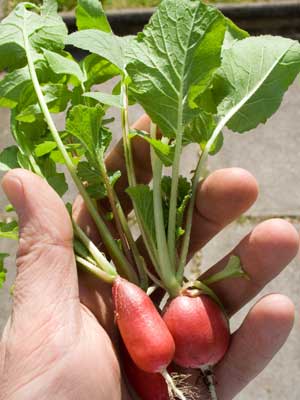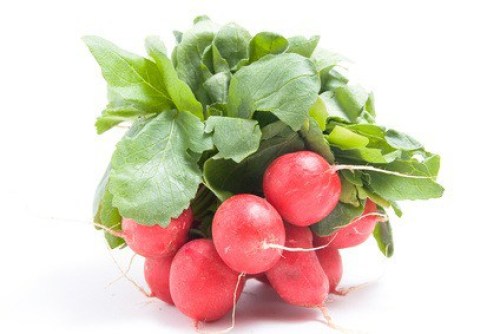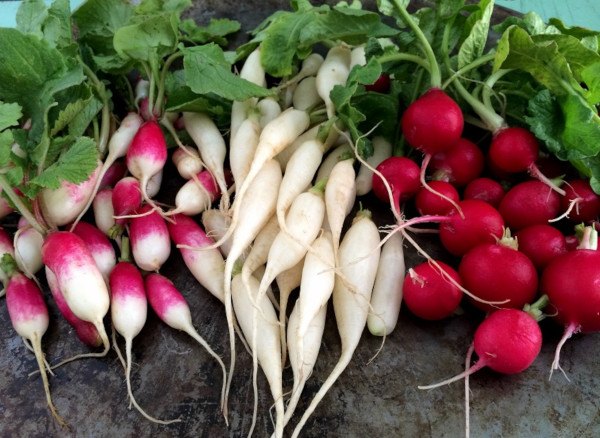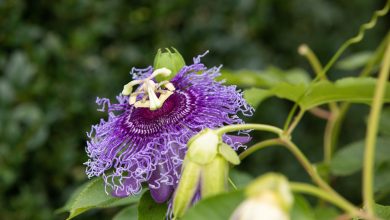How To Grow Radish In The Garden: Complete Guide

Hello to all agrohuerters! In today’s article, we will learn how to grow radish in our gardens in a simple and ecological way. We will see how following a series of indications, it is not necessary to be an expert to be able to produce them yourself. Let’s get started!
Radish Characteristics
The name «radish» comes from the Latin «radix» which means root. This plant originated in China and it is known that the Egyptians and Babylonians already consumed it more than 4000 years ago. It became a highly appreciated food at the time of the Greeks and Romans, the latter being the ones who spread its cultivation throughout Europe.
Its scientific name is Raphanus sativus and it belongs to the Brassicaceae family.It is a plant that can be annual or biennial. The radish is mainly used for its roots, but the leaves can also be consumed.
It is a very good crop to associate with other vegetables such as lettuce or carrots, but it is a good association with practically any vegetable. As its growth is very fast, it is best to associate it with other slower growing vegetables. In this way, when we harvest the radishes, we will leave room for the other plants.
There are more than 50 varieties of different colors and sizes. They are classified according to:
- Shape and size: They can be elongated or rounded. The elongated varieties usually measure between 10-15cm, while the round ones have a diameter of 2-3cm. The weight varies according to the variety, the normal is usually 70 grams, but there are some specimens that can exceed a kilo in weight.
- Color: The outer skin of the radish can be red, pink, white, purple or black. However, the interior is always white (except in some Asian varieties that are pink).
- Taste: Its flavor is slightly spicy.

How to grow radish step by step
Before starting to grow radishes, we have to decide which varieties of radishes we want to plant and we must be clear about some preliminary considerations:
- It develops better in mild temperatures (18-22ºC).
- It can adapt to any type of soil although it prefers deep, clayey and neutral soils.
- A series of cares must be carried out as in other vegetables: irrigation, pest and disease control and an ecological fertilizer.
GROUND PREPARATION
The first thing to do is prepare the land where we are going to grow them. It is recommended to carry out a deep work of turning the earth, where we will take advantage if we want to apply some background fertilizer.
Once the ground is prepared, we proceed to make some ridges that will be flattened creating a kind of plateau where the planting will take place.
SOWING
The most important tips when sowing are:
- Because it requires mild temperatures, it is best to plant it in spring or autumn.
- Planting depth: 1.5 cm and approximate separation of 5 cm.
- Water after sowing.
- A nutritious substrate with good drainage is necessary.
- The radish does not need a transplant, the place where we plant it will be where it develops.
- From the moment of sowing it takes about 5 days for the seeds to germinate and the harvest will take place after about 4 weeks (they grow very fast!)
IRRIGATION
The most important thing is that the soil is always kept moist, without flooding it. Therefore, frequent and uniform watering is necessary.
Over watering:
- Diseases and rot
- radish splits
Low irrigation:
- Spicier taste of radish.
ECOLOGICAL FERTILIZERS
After 15 days you can apply some type of organic fertilizer. I leave you a link about 5 ecological fertilizers that you can use.
CONTROL OF PESTS AND DISEASES
As on other occasions, when growing radish we do not get rid of pests and diseases. That is why I have made another article especially dedicated to radish pests and diseases.
HARVEST
Before harvesting our radishes, we must check that they are ready. To do this, we remove a bit of soil and see if the size they have is adequate. If, indeed, they have a good size, we proceed to remove them by grabbing their leaves and pulling them out. Sometimes the soil is a little compacted and we can help ourselves with a shovel to remove them.
Once we have harvested our radishes, it is recommended to consume them within 2 weeks of harvest. Smaller, freshly picked radishes have more nutrients and a less pungent flavor. Because they have dirt attached to them, we have to wash them or help ourselves with a brush.
As for the leaves, we can use them to make bundles or cut them and put them in the refrigerator in a plastic bag with holes.
This is all for today, I hope you liked the article and that you are encouraged to grow radish! You can leave us your experiences in the comments or a photo if you have this crop in your gardens.
Have a nice day!

![Photo of Temperate Climate: [Characteristics, Flora, Fauna and Adaptability]](https://www.complete-gardening.com/wp-content/uploads/2022/08/temperate-climate-characteristics-flora-fauna-and-adaptability-390x220.jpg)
![Photo of Aloe Arborescens: [Cultivation, Irrigation, Associations, Pests and Diseases]](https://www.complete-gardening.com/wp-content/uploads/2022/08/aloe-arborescens-cultivation-irrigation-associations-pests-and-diseases-300x220.jpg)
![Photo of Sainfoin: [Characteristics, Cultivation, Care and Disadvantages]](https://www.complete-gardening.com/wp-content/uploads/2022/08/sainfoin-characteristics-cultivation-care-and-disadvantages-390x220.jpg)
